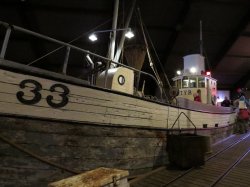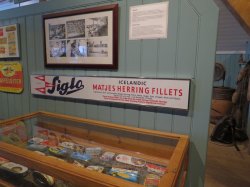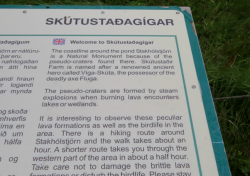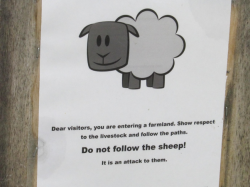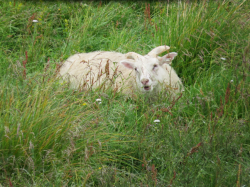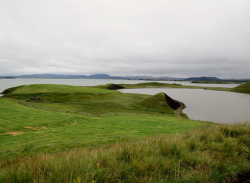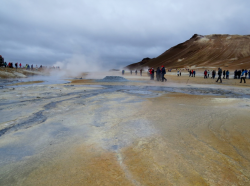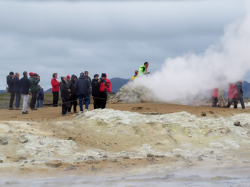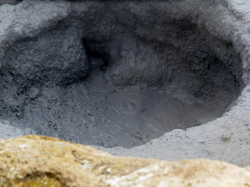You are using an out of date browser. It may not display this or other websites correctly.
You should upgrade or use an alternative browser.
You should upgrade or use an alternative browser.
Góðan daginn Iceland
- Thread starter Pug1
- Start date
- Status
- Not open for further replies.
Noel Mugavin
Established Member
- Joined
- Sep 5, 2010
- Posts
- 1,329
Great report, keep it going
craven morehead
Established Member
- Joined
- Aug 1, 2008
- Posts
- 2,735
- Qantas
- Platinum
- Virgin
- Gold
We then drove to the little village of Arnarstapi with its thriving birdlife and tiny harbour. This was to be our first real sighting of the tiny Arctic Tern with its white body and little black head. The little Terns were nesting in the grasses and would dive bomb you if you got too close even though we stuck to the paths. This area is also a Puffin nesting spot.
View attachment 132921
View attachment 132922
View attachment 132923
Troll Monument
View attachment 132924
Stunning photos !
After Budir we coached back to the ship in Grundarfjordur and sailed for our next destination, Vigur Island. On the sail we passed close to Latrabjarg Cliffs, the most western point in Europe and a huge seabird nesting site. However the local authorities required us to stay well offshore so we didn’t see much apart from a Swiss yacht enjoying a brisk sail to who knows where. They were taking photos of us and vice versa.
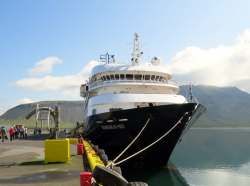
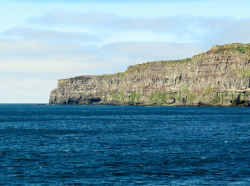
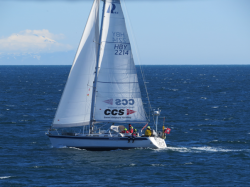



20th July
Vigur Island was to be our first Zodiac landing onto a floating pontoon at the island. The island is in Ísafjarðardjúp fjord and has been owned by the same family for generations. It is a wildlife sanctuary and important breeding area for Arctic Tern, Eider Ducks, Puffin and Guillemots. The family makes its living from tourism and the collection of Eider down. Vigur has one of the smallest post offices in Europe giving you the opportunity to send a postcard or two.
We did a tour of the island with Siri, the daughter of the current occupying generation of her family. Since the little Terns were nesting and quite protective of their nests we had to stick to a marked path and carry flags on sticks for them to attack, instead of our heads! Siri also went through the process they use to collect, clean and dry the Eiderdown. The down is collected by hand after the chicks have left the nest and it is processed in part by machinery but finally by hand to remove the final sticks and other contaminants. Vigur sells about 60kg of down each season and we now know why it is so expensive. After the tour we were served a delicious morning tea with homemade cakes.
Sadly the island is now for sale for around $3m but hopefully it will remain a wildlife sanctuary – any AFF member interested in a bracing life in Iceland? As you can see below it was a rainy/misty day at Vigur.
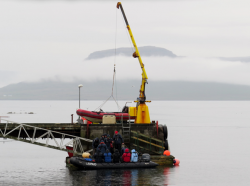
The family home
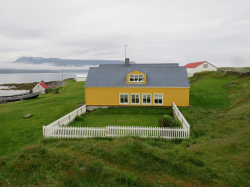
There were lots of these one family/village windmills in Iceland at one time. This one on Vigur is the last one left and is maintained by the Iceland Heritage Trust.
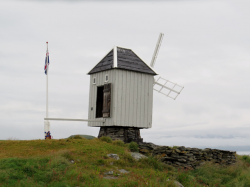
Alfred HItchcock time with the little Arctic Terns. Siri on the right.
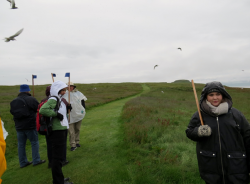
Eider Duck Chicks
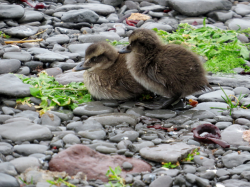
Eiderdown processing room
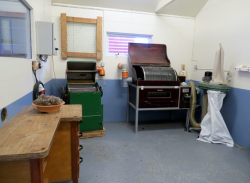
Vigur Island was to be our first Zodiac landing onto a floating pontoon at the island. The island is in Ísafjarðardjúp fjord and has been owned by the same family for generations. It is a wildlife sanctuary and important breeding area for Arctic Tern, Eider Ducks, Puffin and Guillemots. The family makes its living from tourism and the collection of Eider down. Vigur has one of the smallest post offices in Europe giving you the opportunity to send a postcard or two.
We did a tour of the island with Siri, the daughter of the current occupying generation of her family. Since the little Terns were nesting and quite protective of their nests we had to stick to a marked path and carry flags on sticks for them to attack, instead of our heads! Siri also went through the process they use to collect, clean and dry the Eiderdown. The down is collected by hand after the chicks have left the nest and it is processed in part by machinery but finally by hand to remove the final sticks and other contaminants. Vigur sells about 60kg of down each season and we now know why it is so expensive. After the tour we were served a delicious morning tea with homemade cakes.
Sadly the island is now for sale for around $3m but hopefully it will remain a wildlife sanctuary – any AFF member interested in a bracing life in Iceland? As you can see below it was a rainy/misty day at Vigur.

The family home

There were lots of these one family/village windmills in Iceland at one time. This one on Vigur is the last one left and is maintained by the Iceland Heritage Trust.

Alfred HItchcock time with the little Arctic Terns. Siri on the right.

Eider Duck Chicks

Eiderdown processing room

love_the_life
Senior Member
- Joined
- Dec 21, 2012
- Posts
- 5,838
- Qantas
- LT Gold
I remember Vigur Island. I think I have the same photo of the windmill! Sad to hear it’s up for sale. Hopefully there will be sufficient caveats on the contract to keep it safe.20th July
Vigur Island was to be our first Zodiac landing onto a floating pontoon at the island. The island is in Ísafjarðardjúp fjord and has been owned by the same family for generations. It is a wildlife sanctuary and important breeding area for Arctic Tern, Eider Ducks, Puffin and Guillemots. The family makes its living from tourism and the collection of Eider down. Vigur has one of the smallest post offices in Europe giving you the opportunity to send a postcard or two.
We did a tour of the island with Siri, the daughter of the current occupying generation of her family. Since the little Terns were nesting and quite protective of their nests we had to stick to a marked path and carry flags on sticks for them to attack, instead of our heads! Siri also went through the process they use to collect, clean and dry the Eiderdown. The down is collected by hand after the chicks have left the nest and it is processed in part by machinery but finally by hand to remove the final sticks and other contaminants. Vigur sells about 60kg of down each season and we now know why it is so expensive. After the tour we were served a delicious morning tea with homemade cakes.
Sadly the island is now for sale for around $3m but hopefully it will remain a wildlife sanctuary – any AFF member interested in a bracing life in Iceland? As you can see below it was a rainy/misty day at Vigur.
View attachment 132955
The family home
View attachment 132957
There were lots of these one family/village windmills in Iceland at one time. This one on Vigur is the last one left and is maintained by the Iceland Heritage Trust.
View attachment 132958
Alfred HItchcock time with the little Arctic Terns. Siri on the right.
View attachment 132959
Eider Duck Chicks
View attachment 132960
Eiderdown processing room
View attachment 132961
It is terrific to read your TR and see the photos. Makes me want to revisit.
thank you LtL. It would be sad to see Vigur become anything other than a refuge for the Eiders, Puffin, Terns and Seals. I think it's US$3m tooI remember Vigur Island. I think I have the same photo of the windmill! Sad to hear it’s up for sale. Hopefully there will be sufficient caveats on the contract to keep it safe.
It is terrific to read your TR and see the photos. Makes me want to revisit.
Elevate your business spending to first-class rewards! Sign up today with code AFF10 and process over $10,000 in business expenses within your first 30 days to unlock 10,000 Bonus PayRewards Points.
Join 30,000+ savvy business owners who:
✅ Pay suppliers who don’t accept Amex
✅ Max out credit card rewards—even on government payments
✅ Earn & transfer PayRewards Points to 10+ airline & hotel partners
Start earning today!
- Pay suppliers who don’t take Amex
- Max out credit card rewards—even on government payments
- Earn & Transfer PayRewards Points to 8+ top airline & hotel partners
Join 30,000+ savvy business owners who:
✅ Pay suppliers who don’t accept Amex
✅ Max out credit card rewards—even on government payments
✅ Earn & transfer PayRewards Points to 10+ airline & hotel partners
Start earning today!
- Pay suppliers who don’t take Amex
- Max out credit card rewards—even on government payments
- Earn & Transfer PayRewards Points to 8+ top airline & hotel partners
AFF Supporters can remove this and all advertisements
bPeteb
Established Member
- Joined
- May 24, 2011
- Posts
- 3,230
- Qantas
- Platinum
First full day in Reykjavik and our quick discoveries and Icelandic terms
We very soon established that -
It was going to be expensive to eat in Iceland when off the ship.
Icelanders still eat ... Whale...
We loved our very brief trip to Iceland a few years back. Icelanders don't actually eat much whale at all. They sell it to tourists, and the Japanese. Maybe restaurants jack prices up during high summer? We visited during the last week of summer and thought it was no more expensive than many places that we've visited. Five star hotels - yes, very expensive.
Arrived late. Looking forward to working my way through what's been published so far
21st July.
Arrived on Siglufjordur with a misty sail into the lovely town. It was probably our favourite town so we took lots of photos, so I hope I don't overload on them in this TR. Siglufjordur was once the biggest Herring fishing port in Iceland and now has the brilliant Herring Era Museum, which has won Icelandic and overseas awards. The Director of the museum came on board Hebridean Sky to give us a talk on its development. My wife was born in Aberdeen in the North of Scotland, which was also a big fishing port so we were looking forward to our visit to this museum and the demonstration of Herring salting by the local Siglufjordur "Herring Girls". Here are some pictures of this lovely little town.
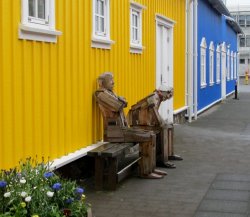
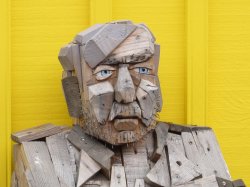

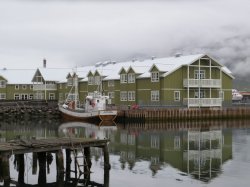
National Geographic Explorer was also moored here
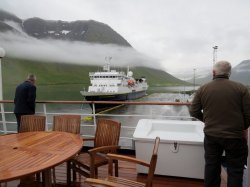
Arrived on Siglufjordur with a misty sail into the lovely town. It was probably our favourite town so we took lots of photos, so I hope I don't overload on them in this TR. Siglufjordur was once the biggest Herring fishing port in Iceland and now has the brilliant Herring Era Museum, which has won Icelandic and overseas awards. The Director of the museum came on board Hebridean Sky to give us a talk on its development. My wife was born in Aberdeen in the North of Scotland, which was also a big fishing port so we were looking forward to our visit to this museum and the demonstration of Herring salting by the local Siglufjordur "Herring Girls". Here are some pictures of this lovely little town.




National Geographic Explorer was also moored here

We walked to the Museum and around the town on our own, and found lots of nice little shops and cafes and a very helpful telco business that sorted out our local Simcard for us. It seems every Icelander in every small town speaks excellent English so we had no problems communicating. In the afternoon we were taken in three groups to the Herring Museum for a demo by the "Herring Girls".
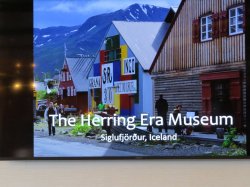
The museum is in three restored/rebuilt buildings and includes a recreated herring factory from salvaged equipment from all over Iceland. There's the salting station, Herring processing factory and accommodation for the girls, and a boathouse with a collection of fishing boats and equipment. We enjoyed seeing the big collection of old photos and memorabilia.
The older ladies from Siglufjorder,(who had experienced working in the factory), give demonstrations for visitors and also taught the younger girls how it was done, so that the tradition was not lost. It was a tough job but one of the few available to women and it gave them financial independence and provided additional income for their families. They lived in the factory, two to a bed, in cramped conditions, during the season. Despite the hard work and extremely long hours the job was in demand for the money it provided.
The demonstration was much fun and was followed by a local man playing accordian and with some of us tourists having a dance on the deck.
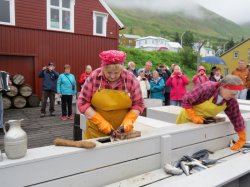
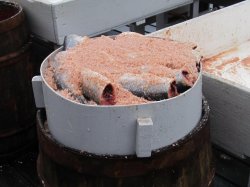
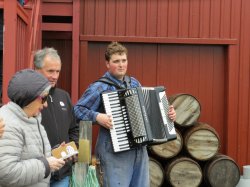
The local gulls waiting for their share of the leftovers
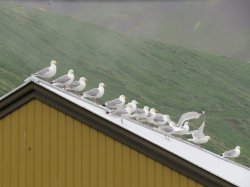

The museum is in three restored/rebuilt buildings and includes a recreated herring factory from salvaged equipment from all over Iceland. There's the salting station, Herring processing factory and accommodation for the girls, and a boathouse with a collection of fishing boats and equipment. We enjoyed seeing the big collection of old photos and memorabilia.
The older ladies from Siglufjorder,(who had experienced working in the factory), give demonstrations for visitors and also taught the younger girls how it was done, so that the tradition was not lost. It was a tough job but one of the few available to women and it gave them financial independence and provided additional income for their families. They lived in the factory, two to a bed, in cramped conditions, during the season. Despite the hard work and extremely long hours the job was in demand for the money it provided.
The demonstration was much fun and was followed by a local man playing accordian and with some of us tourists having a dance on the deck.



The local gulls waiting for their share of the leftovers

Last edited:
Colourful Siglufjordur buildings
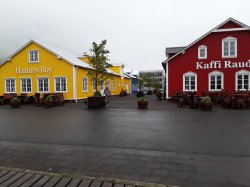
Hebridean Sky daily program for our day in Siglufjordur. As you can see we were kept busy and well fed. Note the presentation by Colin Baird. He is the man who trained and subsequently released Keiko the Orca, on which the film "Free Willy" was based. More on that later.
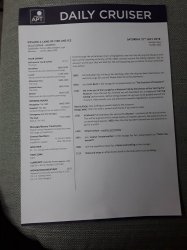
Onwards to Akureyri for the next day's fun. A bit sad to leave little Siglufjordur.

Hebridean Sky daily program for our day in Siglufjordur. As you can see we were kept busy and well fed. Note the presentation by Colin Baird. He is the man who trained and subsequently released Keiko the Orca, on which the film "Free Willy" was based. More on that later.

Onwards to Akureyri for the next day's fun. A bit sad to leave little Siglufjordur.
thank you VPS. I will load more later today. Yes it's well worth a visit especially if you are into photography, sea birds and/or geology.Your photos are great and my desire to visit Iceland has increased exponentially. Thanks - keep going
22nd July Akureyri
Our ship had sailed into Eyjafjordur and docked in Akureyri early in the morning. This is the second largest town in Iceland but we didn’t see much of it as we had a 6am breakfast and then a full day off the ship to see various sights.
Our coaches departed at 7am and we headed over to the other side of the Fjord to Myvatn Nature Baths. The picture below is a new road tunnel that is taking years to construct because of the terrain. The “waterfall” is the outflow from an underground thermal lake they drilled into – oops! The water is 47C flowing into the fjord.
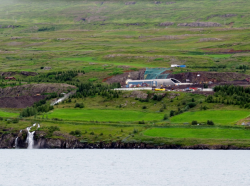
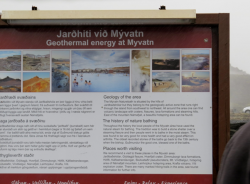
The nature baths are located in the heart of north-east Iceland by Lake Myvatn. The geothermal waters come from depths of up to 2,500 metres and contain a blend of minerals, silicates and geothermal micro-organisms. The complex had opened early for our group and after a quick change and shower we enjoyed an hour or so soaking in the 37C pools. Then it was into the café for a coffee and muffin, feeling 10 years younger. There is also a small gift shop in the complex.
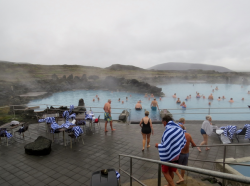
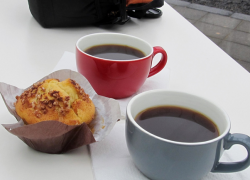
The area around the baths is bare lava fields with smokey fumeroles and little vegetation, but with a strange beauty of its own.
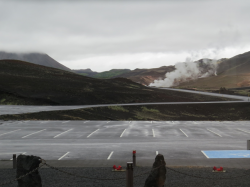
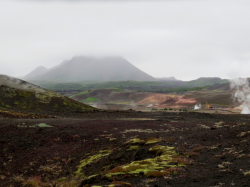
Our ship had sailed into Eyjafjordur and docked in Akureyri early in the morning. This is the second largest town in Iceland but we didn’t see much of it as we had a 6am breakfast and then a full day off the ship to see various sights.
Our coaches departed at 7am and we headed over to the other side of the Fjord to Myvatn Nature Baths. The picture below is a new road tunnel that is taking years to construct because of the terrain. The “waterfall” is the outflow from an underground thermal lake they drilled into – oops! The water is 47C flowing into the fjord.


The nature baths are located in the heart of north-east Iceland by Lake Myvatn. The geothermal waters come from depths of up to 2,500 metres and contain a blend of minerals, silicates and geothermal micro-organisms. The complex had opened early for our group and after a quick change and shower we enjoyed an hour or so soaking in the 37C pools. Then it was into the café for a coffee and muffin, feeling 10 years younger. There is also a small gift shop in the complex.


The area around the baths is bare lava fields with smokey fumeroles and little vegetation, but with a strange beauty of its own.


Our next stop was a weird shaped lava "forest" called Dimmuborgir on private land. It has lots of walking paths and has revegetated with grasses and short Birch forest. The Eurasion and North American Tectonic plate crosses Dimmuborgir and you can have one foot one each side, weird in itself.
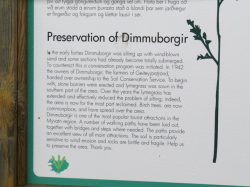
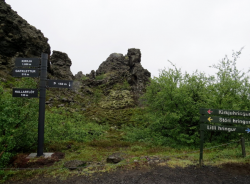
Below is a photo of the Eurasian tectonic plate and the North American tectonic plate. Spanning the Mid-Atlantic Ridge, Iceland
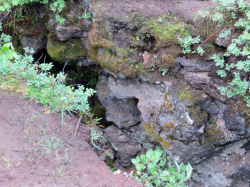
Entry to Dimmuborgir is free but they charge for the toilets (ISK200). what is it about Icelanders and charging for toilets?


Below is a photo of the Eurasian tectonic plate and the North American tectonic plate. Spanning the Mid-Atlantic Ridge, Iceland

Entry to Dimmuborgir is free but they charge for the toilets (ISK200). what is it about Icelanders and charging for toilets?
Our final stop on the way back to the ship in Akureyri was at Godafoss Waterfall, the Waterfall of the Gods. Here, about a 1000 years ago, a Viking chief with an unpronounceable name is reputed to have thrown his Viking God statues into the falls when he made the decision that Iceland was to become Christian, hence the name. It was a rainy day but the falls were still pretty spectactular.
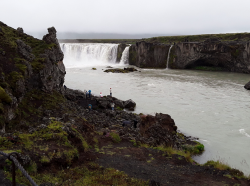
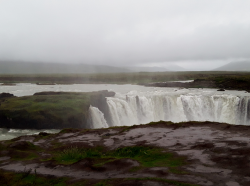


- Status
- Not open for further replies.
Become an AFF member!
Join Australian Frequent Flyer (AFF) for free and unlock insider tips, exclusive deals, and global meetups with 65,000+ frequent flyers.AFF members can also access our Frequent Flyer Training courses, and upgrade to Fast-track your way to expert traveller status and unlock even more exclusive discounts!

AFF forum abbreviations
Wondering about Y, J or any of the other abbreviations used on our forum?Check out our guide to common AFF acronyms & abbreviations.








